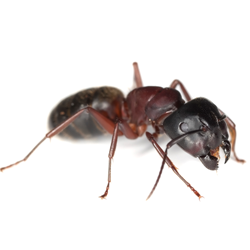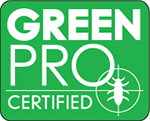Controlling Ants
Out of all household pests, ants are the most common. Sadly, there are several types which can cause issues to the interior and exterior of your home.
Carpenter Ants:

As their name might suggest, these pests are related to wood, wherein they create their nests in wood. Carpenter ants are considered one of the larger types of their species. The impregnated female will dig out enough space in a piece of timber for a nest, and raise her worker ants offspring, up until they can obtain food for themselves and are getting ready for the subsequent carpenter ant generation. One colony of carpenter ants can reach as high as 2000. Despite nesting in wood, they are not like termites which eat it. A structure of timber can be damaged quite severely if a nest is not noticed and remains untreated. If a carpenter ant nest is somewhere inside your home, the cost to repair the damage they cause can be high.
Color – It varies from red to black. However, the black ones are the most common for this region.
Length – Five eighths (5/8)
Diet – They mostly feed on other dead or living insects. However, they also love anything from sweet, sugary foods to fat from meat.
Habitat – Carpenter ants like damp or wet wood so they can create their nest. Old tree stumps and wood which is curing outdoors are the best places to find carpenter ants. Nonetheless, they may find a way into your home, particularly areas which have excess moisture or are wet. There have even been reports of carpenter ants having adapted to much drier climates.
Impact – Carpenter ants are not disease carriers, but they can cause severe damage to a home if they build their nest in the wood and it goes untreated. They tunnel into the wooden structure, causing instability, which can be costly to repair.
Pavement Ants:

Their specific name is taken from the fact that they are found in the crevices and cracks for pavements. Throughout the springtime, the colony is the most active, as they search for a new area to nest.
Color – Usually they are dark brown to black in color.
Length –Up to one eighth (1/8)
Diet –They are not fussy about which food they eat, and their diet can include things like, meat, bread, fat, seeds, insects, grease, honey, and cheese to list a few.
Habitat – As their name implies, they can be found in the cracks and crevices of the sidewalks and pavements or close to the foundations. Also, they live in wood and beneath boards. Mounds of soil and their activity are the things which make the nest visible.
Impact – Pavement ants are not disease carriers, nor do they cause any health risks, however, their excrement can cause food contamination.







 Ants
Ants Bed Bugs
Bed Bugs Bees & Wasps
Bees & Wasps Beetles
Beetles Cockroaches
Cockroaches Earwigs
Earwigs House Crickets
House Crickets Fleas
Fleas Flies
Flies Mosquito
Mosquito Moths
Moths Rodents
Rodents Silverfish
Silverfish Spiders
Spiders termites
termites Tick
Tick